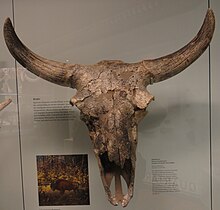Bison schoetensacki, commonly as the Pleistocene woodland bison or Pleistocene wood bison, was a species of bison that lived from the Early Pleistocene to at least the early Middle Pleistocene from western Europe to southern Siberia.[1] Its presence in the Late Pleistocene is debated.[2]
| Bison schoetensacki Temporal range:
| |
|---|---|

| |
| Fossil of Bison schoetensacki at the State Museum of Natural History Stuttgart | |
| Scientific classification | |
| Domain: | Eukaryota |
| Kingdom: | Animalia |
| Phylum: | Chordata |
| Class: | Mammalia |
| Order: | Artiodactyla |
| Family: | Bovidae |
| Subfamily: | Bovinae |
| Genus: | Bison |
| Species: | †B. schoetensacki
|
| Binomial name | |
| †Bison schoetensacki Freudenberg, 1910
| |
Description
editB. schoetensacki was generally similar to extant European bison in shape although there could have been morphological variations among European bisons during late Early Pleistocene and Early Holocene.[3]
In comparison to B. priscus, B. schoetensacki was either smaller or similar in size but with slenderer leg bones and metapodials, and had shorter and differently shaped horns.[4]
Diet
editDespite its common name, B. schoetensacki was probably not a mix-feeder, like the extant American wood bison. Instead, dental mesowear of the species shows similar pattern to that of extant European bison, a grazer.[1]
Paleobiology
editDuring the Late Early and Early Middle Pleistocene, B. schoetensacki was the most common large bovid in Europe.[5] Fossils have been obtained from Czech Republic, England, France, Germany, Greece, Italy, Moldova, Russia, Spain,[2][6] and mass excavations from the Paleolithic site of Isernia in Italy, dating back to around 700,000 years ago, indicate B. schoetensacki was the most heavily targeted animal by human hunters,[7] as European bison likely didn't inhabit the Italian and Iberian Peninsulas.[1]
Ranges of B. schoetensacki and steppe bison presumably overlapped for some extents.[1]
Genetics
editA 2017 study which attributed Late Pleistocene European remains to B. schoetensacki found it to belong to a mitochondrial clade which is the sister group to modern wisent, and proposed the species as a whole is likely ancestral to modern wisent.[8][2] However, other studies have disputed this attribution, restricting B. schoetensacki to Early and Middle Pleistocene remains.[9]
References
edit- ^ a b c d Roman Uchytel. "Pleistocene woodland bison". Prehistoric-Fauna.com. Retrieved 2021-10-11.
- ^ a b c Palacio, Pauline; Berthonaud, Véronique; Guérin, Claude; Lambourdière, Josie; Maksud, Frédéric; Philippe, Michel; Plaire, Delphine; Stafford, Thomas; Marsolier-Kergoat, Marie-Claude; Elalouf, Jean-Marc (10 February 2017). "Genome data on the extinct Bison schoetensacki establish it as a sister species of the extant European bison (Bison bonasus)". BMC Evolutionary Biology. 17 (1): 48. Bibcode:2017BMCEE..17...48P. doi:10.1186/s12862-017-0894-2. ISSN 1471-2148. PMC 5303235. PMID 28187706.
- ^ Leonardo Sorbelli, Marco Cherin, David M. Alba, Joan Madurell Malapeira, 2021, A review on Bison schoetensacki and its closest relatives through the early-Middle Pleistocene transition: Insights from the Vallparadís Section (NE Iberian Peninsula) and other European localities, edited by Danielle Schreve, Quaternary Science Reviews, Volume 261, DOI:106933, The Early-Middle Pleistocene Transition in Mediterranean Europe
- ^ Marsolier-Kergoat, Marie Claude (2017). Evolutionary Biology: Self/Nonself Evolution, Species and Complex Traits Evolution, Methods and Concepts. Springer International Publishing. pp. 187–198. ISBN 9783319615691.
- ^ Sorbelli, Leonardo; Alba, David M.; Cherin, Marco; Moullé, Pierre-Élie; Brugal, Jean-Philip; Madurell-Malapeira, Joan (1 June 2021). "A review on Bison schoetensacki and its closest relatives through the early-Middle Pleistocene transition: Insights from the Vallparadís Section (NE Iberian Peninsula) and other European localities". Quaternary Science Reviews. 261: 106933. Bibcode:2021QSRv..26106933S. doi:10.1016/j.quascirev.2021.106933. Retrieved 5 May 2024 – via Elsevier Science Direct.
- ^ Leonardo Sorbelli, Marco Cherin, David M. Alba, Joan Madurell Malapeira, 2019, The Epivillafranchian Bison schoetensacki sample from the Vallparadís Section, The Early-Middle Pleistocene Transition in Mediterranean Europe
- ^ Thun Hohenstein, Ursula; Di Nucci, Annarosa; Moigne, Anne-Marie (January 2009). "Mode de vie à Isernia La Pineta (Molise, Italie). Stratégie d'exploitation du Bison schoetensacki par les groupes humains au Paléolithique inférieur". L'Anthropologie (in French). 113 (1): 96–110. doi:10.1016/j.anthro.2009.01.009.
- ^ Marsolier-Kergoat, Marie-Claude; Elalouf, Jean-Marc (2017), Pontarotti, Pierre (ed.), "The Descent of Bison", Evolutionary Biology: Self/Nonself Evolution, Species and Complex Traits Evolution, Methods and Concepts, Cham: Springer International Publishing, pp. 187–198, doi:10.1007/978-3-319-61569-1_10, ISBN 978-3-319-61568-4, retrieved 2022-02-10
- ^ Grange, Thierry; Brugal, Jean-Philip; Flori, Laurence; Gautier, Mathieu; Uzunidis, Antigone; Geigl, Eva-Maria (September 2018). "The Evolution and Population Diversity of Bison in Pleistocene and Holocene Eurasia: Sex Matters". Diversity. 10 (3): 65. doi:10.3390/d10030065. S2CID 52062297.